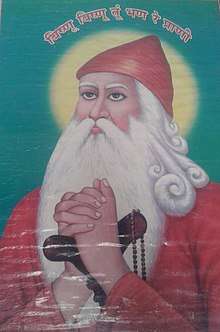Guru Jambeshwar
Guru Jambeshwar, also known as Guru Jambhoji, (1451-1536) was the founder of the Vishnoi sect. He was incarnation of Lord Vishnu. He taught that God is a divine power that is everywhere. He also taught to protect plants and animals as they are important in order to peacefully co-exist with nature.
| Guru Jambeshwar | |
|---|---|
 Guru Jambeshwar | |
| Affiliation | Vishnoi, Bishnoi |
| Major cult center | Mukam, Samrathal, Jambholav Dham, Pipasar, Naurangi nagar(Rotoo), |
| Mantra | "Vishan Vishan tu bhan re prani" |
| Region | Rajasthan , India |
| Ethnic group | Hindu |
| Festivals | Janmastmi |
| Parents | Thakur Lohatji Panwar and Hansa Devi |
Biography
Jambeshwar was born in a Rajput family of the Panwar clan in the village of Pipasar, Nagaur district in 1451.[1] He was the only child of Lohat Panwar and Hansa Devi. For the first seven years of his life, Guru Jambeshwar was considered silent and introverted. He spent 27 years of his life as a cow herder.
Aged 34, Guru Jambeshwar founded the Vishnoi sect. His teachings were in the poetic form known as Shabadwani.[2] He preached for the next 51 years, travelling across the country, and produced 120 Shabads, or verses, of Shabadwani. The sect was founded after wars between Muslim invaders and local Hindus. He had laid down 29 principles to be followed by the sect. Killing animals and felling trees were banned. The Khejri tree (Prosopis cineraria), is also considered to be sacred by the Vishnois.
Vishnoism revolves around 29 rules. Of these, eight prescribe to preserve biodiversity and encourage good animal husbandry, seven provide directions for healthy social behaviour, and ten are directed towards personal hygiene and maintaining basic good health. The other four commandments provide guidelines for worshipping God daily. you must read the book which is written by *Chandla, M. S. (1998). Jambhoji: Messiah of the Thar Desert (PDF). Aurva Publications.
Legacy and commemoration
Guru Jambeshwar University of Science and Technology at Hisar in Haryana is named after him.
See also
References
- Jambhoji: Messiah of the Thar Desert - Page xiii
- Jain, Pankaj (2011). Dharma and Ecology of Hindu Communities: Sustenance and Sustainability. Routledge. ISBN 978-1-40940-591-7.